It has become a somewhat common trend to try and eliminate a stereo preamp, particularly in digital-only systems. Connecting an amplifier directly to an audiophile DAC, to some, saves money on component costs, cable costs, and, theoretically, provides a shorter signal path. For any system with more than one meaningful source, though, a preamp is a requirement. That isn’t the only benefit to using a preamp, though. Boulder’s 1110 preamp is designed to highlight those benefits to those seeking very high-performance switching, volume control, and more. $24,000 is big bucks by anybody’s measure. Let’s see how Boulder—a company known for its power amplifiers—does with a high-end preamp…
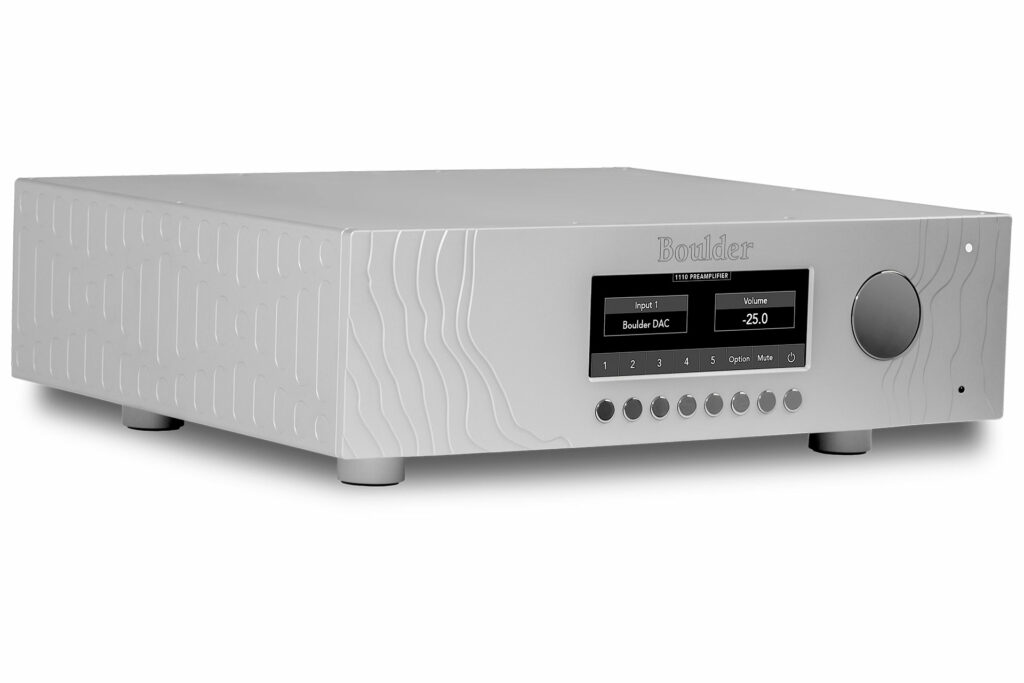
What Makes the Boulder 1110 Stereo Preamp Special?
- As with every product Build builds, quality is paramount. Almost every part of the manufacturing process is done in Boulder’s Colorado facility. This includes design, engineering, machining, and metal fabrication on close-tolerance CNC equipment. Additionally, the company builds its own surface-mount and through-hole circuit boards on in-house pick-and-place machines with wave soldering. All assembly, testing, packaging, and shipping is also done in house. Boulder goes to extraordinary lengths to exert as complete control as possible over every aspect of production to assure the ultimate in quality and performance. You might find different ways of going about building an audiophile component, but unlikely a better way.
- The Boulder 1110 can accept five different inputs, which should be more than sufficient for most audiophile systems.
- Each of the five rear-mounted XLR connections is logically laid out with each input beside the next, with the left channel on top and the right directly beneath. In systems where room behind an equipment rack is somewhat limited, this makes finding connections much easier.
- There are five front-mounted buttons to easily switch between sources. Out of the box, they are labeled as Source 1, Source 2 and so on. A custom name, such as DAC or Phono, may be assigned to any of the sources making identifying which source is connected to which input quite simple.
- The remaining three front-mounted buttons are for power, mute, and an options button to further customize the preamp’s operation. Custom options principally include balance, Absolute Polarity inversion from 0 degrees to 180 degrees, and display brightness.
- Somewhat unique is the Right Channel Polarity selection. Where Absolute Polarity works on both channels, Right Channel Polarity only adjusts the right channel. This is especially useful when trying to determine if a speaker cable or interconnect is mistakenly reversed and is a very thoughtful little feature that adds to the value of this lofty preamp.
- Each of the five inputs has what Boulder calls Input Trim, and I learned to love it. When this function is selected, the level of that specific input may be adjusted. This is an extremely useful feature, as it allows different sources, such as a DAC and a phono stage, to be level matched. This eliminates having to adjust the volume when switching between sources – very useful when doing comparisons.
- Lastly, each source may be switched to Theater Mode, where the input may be used in a Home Theater application or an auxiliary output for a tape loop if you roll like that these days. Cassette decks are trendy, and reel-to-reel players are making a comeback on sheer cool factor if for no other reason.
- The front-mounted volume control is a round knob but not a knob in the traditional sense. Borrowed from the cost-no-object 3000 series of Boulder products, it is flush mounted, and to attenuate volume the button is rotated with one finger to increase or decrease amplitude. Because the volume section is all optical, the movement is completely effortless. There are no steps, clicks, no relays, or any mechanical operation involved. Having a completely optical volume control decouples the volume circuits when not in use.
- As in other Boulder products, the 1110 preamp is fully differentially balanced from input to output. Internal separation of components and galvanic isolation are utilized throughout.
- Borrowed from the 2000 series and also used in the 1160 amplifier, a brand new 983 gain stage provides extreme sonic neutrality and makes allowances for long cable lengths. This is something very few if any DACs connected directly to an amplifier can provide.
- A reasonably sized display screen shows perinate information and may be adjusted for brightness or turned off completely.
- The Boulder 1110 preamp may be connected to the Internet so software updates may be downloaded and installed. Pretty nice.
- A full-featured remote, machined from aluminum, is included.
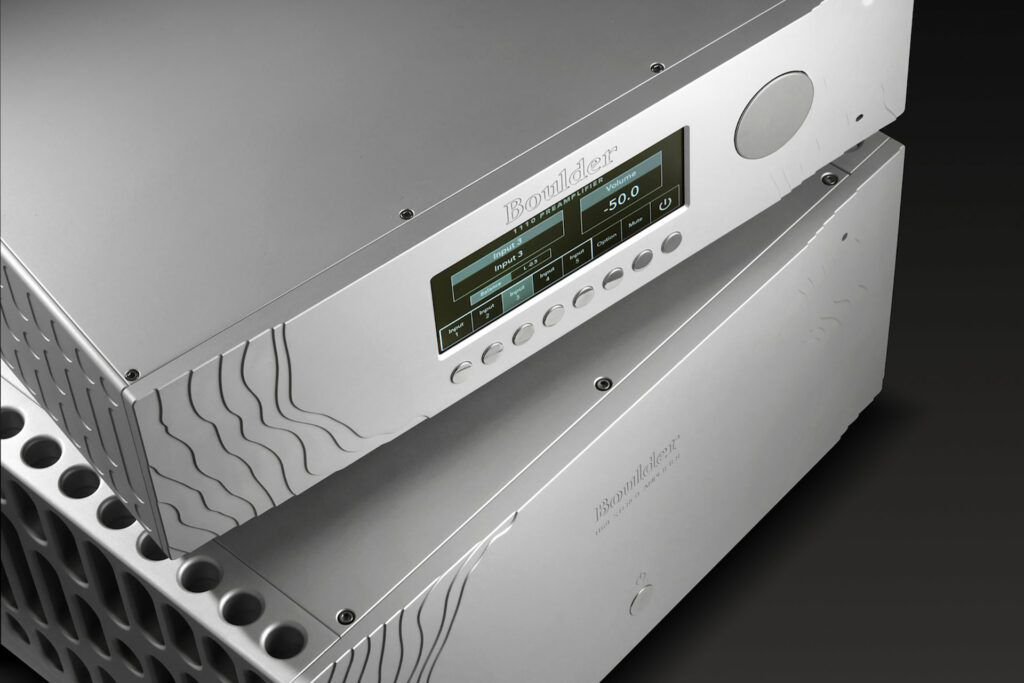
Why Should You Care About the Boulder 1110 Preamp?
Anyone who spends $24,000 for a preamp will be using it in a very advanced audiophile system. Such systems are typically predicated on providing a completely neutral sonic presentation. The Boulder 1110 Preamp is such a device—one that does not especially assert any of its own tonal colorations. There are other stereo preamps that add color or flavor to your sound, but that isn’t the goal or the result with the Boulder 1110.
Boulder, with its fanatical commitment to quality, has delivered a preamp with outstanding relative cost. So in systems of like value and performance, this is a preamp that may be used and enjoyed for years (or decades) to come. In fact, Boulder designs all its products for just this purpose. Without question, the Boulder 1110 is a very, very expensive preamp. It will be useable for quite a few years to come.
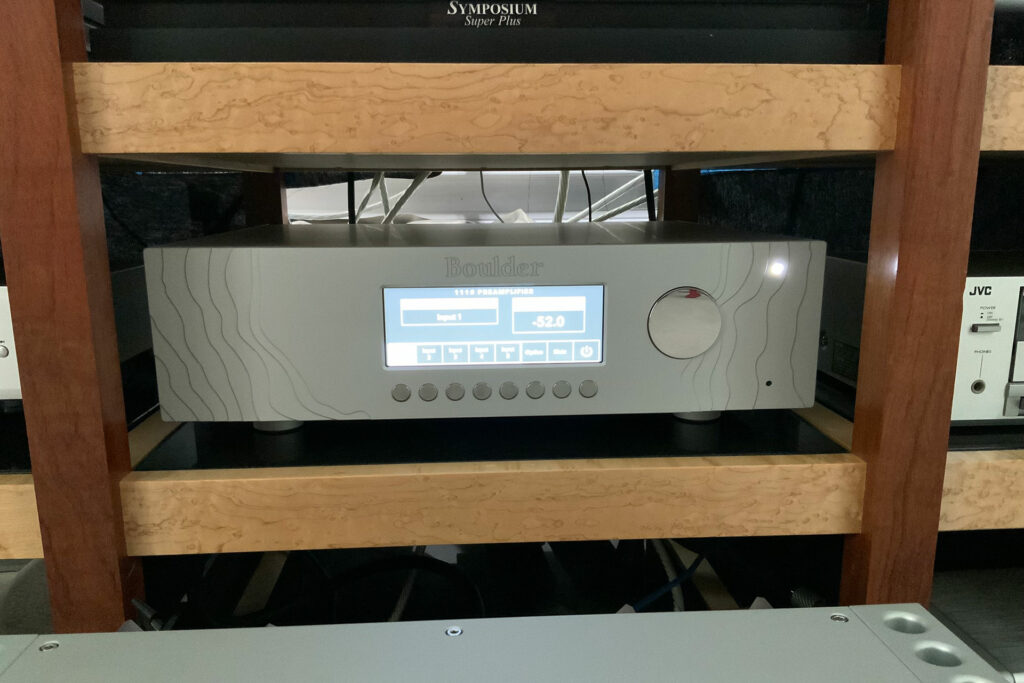
Some Things You Might Not Like About the Boulder 1110 Preamp
- There are no provisions for RCA inputs. Boulder simply does not believe in RCA terminations. They do, however, offer an adaptor to allow connection of an RCA cable to an XLR input.
- While the display screen may be adjusted for brightness, it is a dark background with white writing. I found the display a little difficult to read from even five-or-so feet away. In my listening position, I could not really read the screen at all. When adjusting the volume, it would be very useful if the actual setting would double or triple in size and then return to normal when volume adjustment has ceased. This would make determining the actual amplitude far easier from a distance.
- While most listeners will use the remote, the volume button is completely free spinning. If given a good, hard spin, it will continue to rotate until the momentum wears off. If a child were to wander into an audio room and spin the round button to the right, the volume will quickly and very sharply increase. This could potentially cause damage to components, speakers, and depending on the amp,possibly ears.
Listening to the Boulder 1110 Preamp…
Many manufacturers claim sonic neutrality, yet fall somewhat short on delivery. With the Boulder 1110 preamp, a mostly neutral presentation is what you will hear. Recordings will be presented as they are. When using the 1110 preamp, what I found, mostly regardless of the amplifier, was a very dynamic and lively sound with exceptional detail and clarity. In general, the imaging was excellent, but I will admit not quite as wide as my T+A amp and preamp, but not so much as to be anything negative. In every other respect, imaging between the two was very compatible.
Where the Boulder 1110 preamp excelled was in the bass. Seldom have I heard tighter, more controlled and more realistic bass in my audio room. Boulder claims not to voice its components, and I would submit that with the 1110 preamp they have succeeded in the effort. What I heard, in short, was music.
Originally released in 1971, Yes’ Fragile has long been a favorite. I have multiple versions on both CD and LP and even a MoFi Ultradisc One Step version. On the track “Roundabout,” (CD version) the remarkable ability of the Boulder 1110 to ferret out detail was on full display. The clarity was exceptional, which, surprisingly enough, made listening to the vocal track quite easy. It is simple to otherwise get lost in Rick Wakeman’s keyboard work and the drums and percussion ably performed by Bill Bruford. What really set this track apart, not surprisingly, was the incredible bass work by Chris Squire. Having really paid attention to the bass line, I feel it is one of the better bass tracks in Rock and Roll and the 1110 helped make it sound excellent.
It would be fair to say Sugarland is one main reason I developed an interest in Country music. Jennifer Nettles has an amazing voice and ranks among my favorite performers. Now, normally, I’m mostly apathetic towards Taylor Swift, but whereupon discovering the song “Babe” from the Sugarland, Bigger release, I immediately developed a liking for this track. Nettles showcases her vocal talents, and say what you will about Ms. Swift, she holds her own as well. In fact, Taylor Swift even wrote the track for Sugarland.
While not likely heard on a lower end rig, on my system with Boulder 11100 preamp in the loop, Swift’s backing vocals, like the refrains “babe” (sometimes sounding like “abe”) and “this is the last time” bounce back and forth from far right to far left. With the Boulder 1110’s ability to provide excellent imaging, this bouncing effect was in a completely different space than Nettles’ vocals, as was Swift’s voice. Both performers have an excellent dynamic quality and the music is easily distinguished by instrument – such as the bass line apart from the kick drum. All in all, a great track performed by two veritable powerhouse vocalists.
Does the Boulder 1110 Preamp Have Any Resale Value?
Used equipment pricing is based on the component itself, overall popularity in the market, and initial retail price. Because Boulder products in general last so long and provide years of trouble-free performance, finding them used at any price may be difficult, if not fully impossible.
Add to that, Boulder does not retire any component they make until a replacement with a significant leap forward is available. Given the quality of its products in general, their ability to last for many years, and the knowledge that a new version won’t be likely be introduced until well into the future certainly influences the availability of used equipment. When they do appear used, however, resale prices are excellent and should command an initial price of 50 percent of retail at a minimum – if not much higher. So that’s a very strong yes in the resale department as Boulder is an investment as much as it is an audiophile purchase.
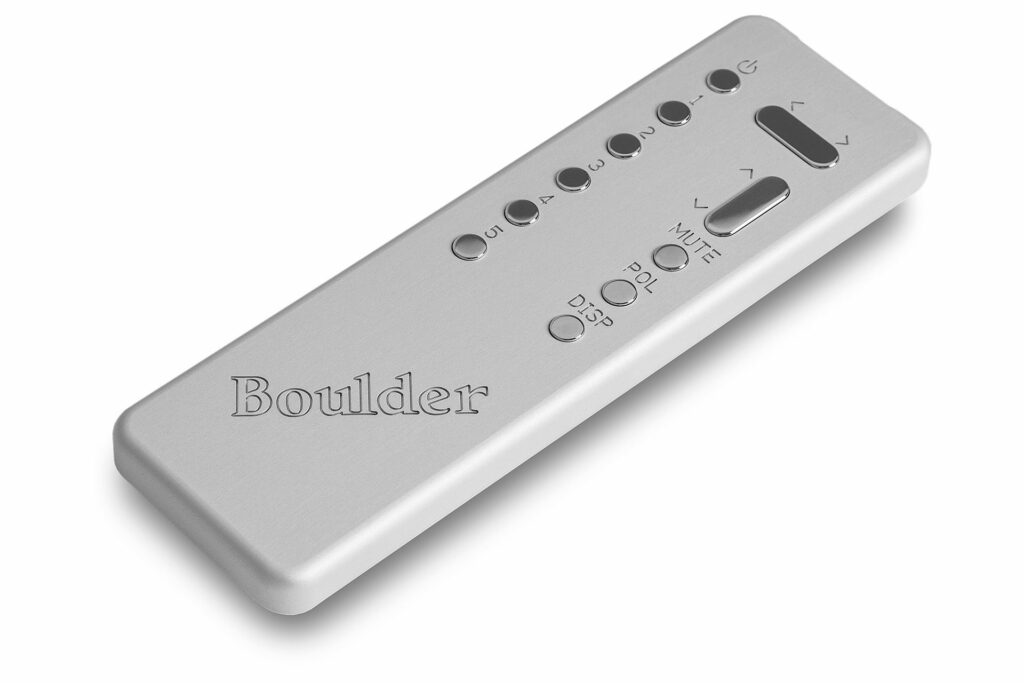
Who Is the Competition for the Boulder 1110 Preamp?
Let’s begin with the very well made and absolutely gorgeous D’Agostino Progression Preamp ($25,950). These two preamps are mostly similar but there are differences. Most notable are the famed meters D’Agostino puts on almost everything. Second, the power supply is separately housed and connected by a supplied cable. One notable difference is where Boulder uses a completely optical volume control circuit, D’Agostino uses a balanced resistor ladder type. D’Agostino also has specific inputs for various components such as DAC, Server, Theater, and so on. Most notably, the Progression has an optional DAC module that can be connected to add digital functions to the preamp. This feature costs an additional $6,950.
Classified as a line source for “simpler systems,” the Constellation Revelation Pictor, at $24,500, features three inputs compared to the Boulder 1110’s five. The Revelations does have a separate power supply and, like Boulder, uses isolated circuitry to prevent crosstalk. It is also a fully differentially dual mono from input to output design. An optional DC Filter used to clean the DC input retails for $8000. You can buy both together for a price of $30,000.
As with the Boulder 1160 amplifier, my real interest was comparing my reference T+A P3100HV preamp to the Boulder 1110. With the T+A priced at $24,500, both units are very compatible. T+A actually has four inputs with both XLR and RCA and two RCA-only inputs for a total of six. There is also one tape recorder input. One input may be configured for theater bypass mode. There are both XLR and RCA outputs, one for each channel, on the P3100HV. T+A uses two power supplies, one for each channel, both electrically and galvanically separated, thus necessitating two power cords. As with all equipment in the T+A HV series, the P3100HV utilizes high voltage rail technology intended to deliver greater linearity and effect a more tube-like sound. Sonically, I found both to be very similar in terms of imaging, detail clarity, and dynamics. However, when used in partnership with the Boulder 1160 Stereo Amplifier, the 1110 Preamp delivered some of the finest bass response I have ever heard on my system in my audio room.
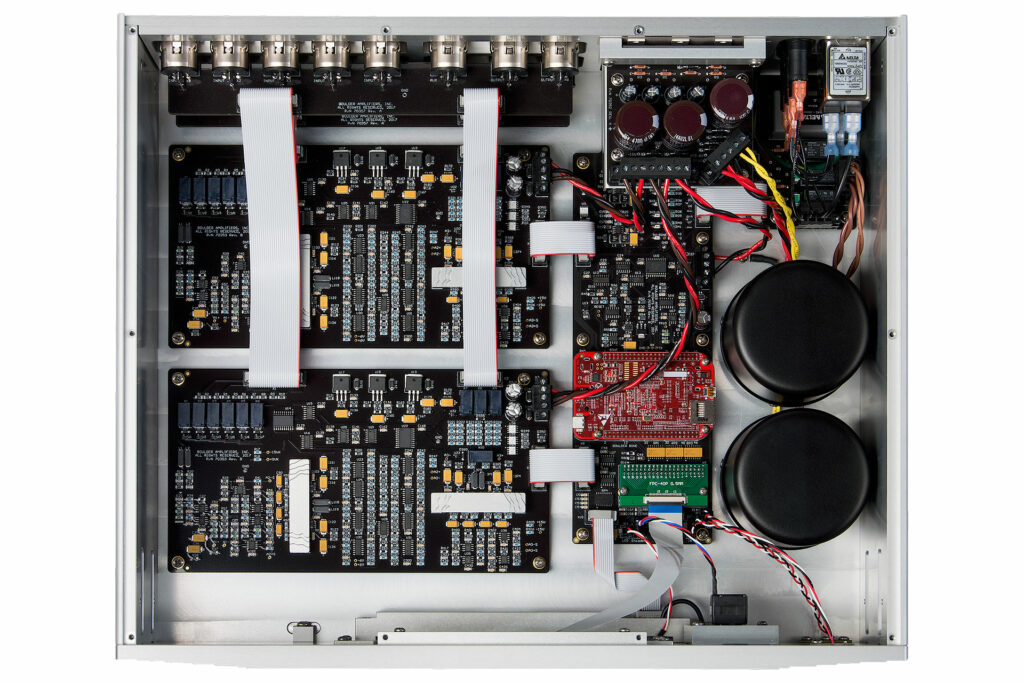
Final Thoughts on the Boulder 1110 Stereo Preamp
When we contacted Boulder about a review sample, instead of just an amp or preamp, they suggested both the Boulder 1160 stereo amp (reviewed here) as well as the 1110 preamp. Boulder seems to believe, as do I, in a system synergy approach especially when it comes to electronics. Having spent considerable time with both Boulder components, and using them both independently and with each other, as good as each one is separately, I feel they are better together,playing as a team – not that you wouldn’t draft either one of these players if you ever get a chance when building your audiophile franchise.
In regard to the 1110 preamp, like all Boulder gear, it is phenomenally well built, has a wide range of features, some not even found on preamps costing much more. With Boulder’s reputation for excellence and world-class performance, any audiophile considering spending $20,000 or more on a preamp should make plans to audition this one.
It offers excellent features and sonically is decidedly clean, clear, with superior neutrality, nearly visceral dynamics, and remarkable bass response. All in all, spending this much for a preamp is a dedicated decision. Doing so, however, will bring to bear a component that will be enjoyed for many years. Sending this preamp back to Boulder for me came far too soon. Cost aside, this is a remarkable preamp and one that could live and thrive in almost any audio system. While it was here, it certainly did in mine.




Hi Paul, I just picked up a P 3000 HV and compared to my Pass Labs X1 I was quite disappointed in resolution and bass slam. Not sure if it needs more break in (this was a demo unit from the dealer and perhaps I’m using a different input than they were), but given the T + A costs 2.5X the amount of the Pass, I’m less than impressed. Soundstage shrunk as well. It isn’t as involving as the Pass. Do you have any advice? Thinking about trying the Boulder or an EMM labs PRE.